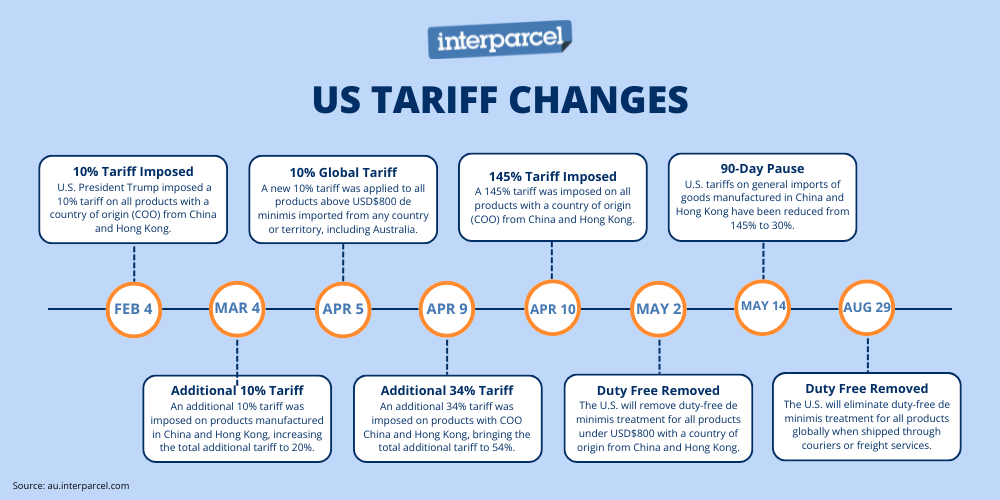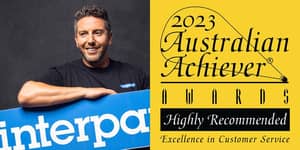As of May 14 2025, new U.S. import tariffs have significantly altered the cost of shipping for ecommerce businesses selling into the U.S.
In this guide, we’ll walk you through:
- What’s Changed with U.S. Tariffs (July 2025 Update)
- How This Affects International Shipping
- What You Can Do to Minimise the Impact
Please note: While this guide is here to help you navigate the latest tariff changes, every business and shipment is different. We recommend cross-checking your specific shipping requirements or seeking professional advice to ensure everything’s in order before sending goods internationally.
🚨 What’s Changed with U.S. Tariffs (August 2025 Update)
Effective August 29, 2025, the U.S. government has suspended the duty and tax-free exemption for imported goods valued at or below USD $800. This change applies to all countries, including those previously exempt.
The U.S. will eliminate duty-free de minimis treatment for all products globally when shipped through couriers or freight services.
What this means for low-value shipments:
- All shipments valued at or under USD $800 will now be subject to applicable duties and taxes.
- These shipments will require formal or informal customs clearance by a licensed customs broker.
- Customers must provide accurate and complete shipment information to avoid delays.
- Processing times may be longer due to the additional clearance requirements.
- Duties and taxes must be paid according to standard entry and payment procedures.
Please Note: Goods imported from Hong Kong and China have already been subject to duties since May 2025.

How the New U.S. Tariffs Will Impact Your Shipping
If you’re selling to customers in the U.S., the suspension of the duty-free De Minimis exemption is a game-changer. Until now, parcels valued at $800 USD or less could enter the U.S. without paying duties or taxes. But from August 29, 2025, that benefit will no longer apply to shipments sent via couriers, express services, or freight forwarders.
This means that every shipment to the U.S., no matter where your products are made or how low their value is, will now be subject to U.S. duties and taxes. For Australian retailers, this translates to higher landed costs, which could directly impact your pricing strategy, profit margins, and even the competitiveness of your offering in the U.S. market.
Beyond the financial hit, you should also prepare for longer customs clearance times. The new regulations will trigger more detailed inspections and stricter enforcement, leading to potential delays in delivery. If speed and reliability are key selling points for your U.S. customers, this could affect customer satisfaction and return purchase rates.
In short, these changes will force many businesses to rethink their pricing models, supply chain workflows, and fulfilment strategies. Now is the time to review how these new costs and delays will affect your U.S. operations, and explore solutions like adjusting shipping methods, consolidating shipments, or absorbing costs in your pricing.
What You Can Do to Minimise the Impact
1. Get Your Commercial Invoice Right for U.S. Shipments
Accurate and complete commercial invoices are essential when shipping to the U.S., not only to avoid customs delays and inspections, but to ensure your goods aren’t overcharged with duties or refused entry.
Here’s what you need to know:
For all shipments to the U.S., make sure your commercial invoice includes:
- Sender and receiver details
- Your Tax Status
- Reason for Export
- Required Identification Numbers
- For each product:
- A clear, specific product description (what is it and what's it made of?)
- Quantity
- A 10-digit HS Code (check here to find the correct code and watch this video to learn more)
- The country of manufacture
- The product’s value and currency
Additional requirements to be aware of:
- A Manufacturer Identification Code (MID) is typically needed for textile products for commercial use. If required, you can add this in the product description. For more information on what products require a MID code and how to generate it, click here: MID Information.
- Formal entry for high-value shipments: If your shipment is valued over $2,500 USD, it will require formal entry and must include an EIN (for businesses) or SSN (for individuals). You can include them in the product description when shipping with Interparcel.
For more detailed guidance, visit FedEx’s U.S. tariff and shipping information page.
Getting your commercial invoice right the first time ensures smoother customs clearance and helps avoid costly delays and fees.
2. Communicate Proactively with Your Customers
Unexpected delivery fees or delays can impact customer trust, especially during peak sales periods.
With the new U.S. tariffs in place, many products are now subject to stricter documentation checks at customs. These inspections can lead to unexpected delays or added fees if the paperwork isn’t perfect.
What you can do:
- Add a note at checkout about potential delays or fees on U.S. orders
- Update delivery estimates on your product pages and in shipping notifications
- Email customers to explain any pricing or shipping changes
Transparency goes a long way in retaining customer loyalty, especially when shipping timelines or costs may be affected by forces outside your control.
3. Diversify Your Export and Manufacturing Strategy
Reducing reliance on high-risk supply chains can protect your business long term.
Consider:
- Exploring less-affected export markets (e.g. New Zealand, the UK, Canada)
- Building relationships with alternative manufacturers in Vietnam, India, Indonesia, or Australia
4. Recalculate Pricing to Protect Your Margins
With tariff costs rising, it’s recommended to revisit your pricing strategy.
What to consider:
- Factor new import duties into your landed cost calculations
- Reassess your product margins, especially for U.S. customers
- Decide whether to absorb the cost, pass it on, or split it with the customer
You may also want to explore tiered pricing, bundle deals, or volume discounts to stay competitive without sacrificing profitability.
5. Access Australian Government Support
The Australian Government is offering guidance and tools to help businesses affected by tariff changes:
- Export Market Development Grants (EMDG)
- Business advisory services
- Educational webinars
Explore: Government Support for Exporters
If you have any questions about how these changes impact your shipments to the U.S., our customer support team is here to help. Contact us for expert guidance on navigating these new regulations and ensuring smooth international shipping.










 Facebook
Facebook Twitter
Twitter Instagram
Instagram Linked In
Linked In YouTube
YouTube